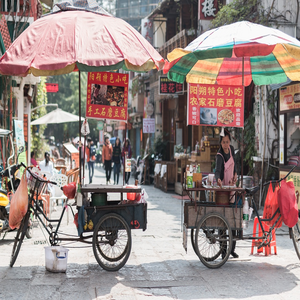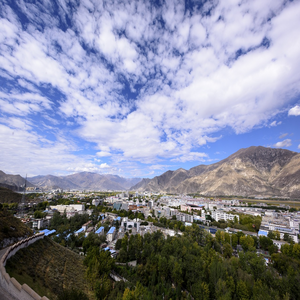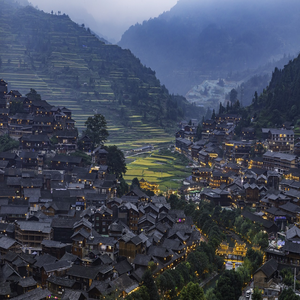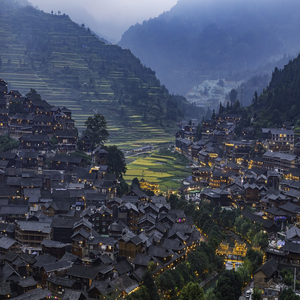
Lhasa Attractions
Lhasa, the capital of Tibet, is a must-visit destination for anyone interested in Tibetan culture, Buddhism, and stunning Himalayan landscapes. Here is an inspiring travel guide to Lhasa, full of things to see, do, and experience in this unique and beautiful city:
1. Visit the Potala Palace: This iconic UNESCO World Heritage Site is a symbol of Tibetan culture and history. Once the winter residence of the Dalai Lama, the palace is now a museum that showcases ancient Tibetan architecture, art, and the rich history of this amazing city.
2. Explore Jokhang Temple: Considered the most sacred temple in Tibet, Jokhang is a major pilgrimage site for Tibetan Buddhists. The temple is home to some of the most precious artifacts, statues, and relics in Tibetan Buddhism.
3. Walk around Barkhor Street: This vibrant street around Jokhang Temple is a bustling hub of local life and commerce. You can see locals prostrating themselves in front of the temple, browse through a vast array of traditional Tibetan clothing, souvenirs, and handicrafts, and taste some local delicacies.
4. Admire Norbulingka Palace: Located on the outskirts of the city, this picturesque summer palace was once the residence of Dalai Lamas. With its peaceful gardens, beautiful lakes, and traditional architecture, Norbulingka is the perfect place to escape the bustle of the city.
5. Wander around Sera Monastery: One of the three major Gelugpa monasteries in Tibet, Sera is famous for its daily monk debates. Hundreds of monks come to this serene temple courtyard to practice their debating skills and engage in intellectual discourse.
6. Take a day trip to Namtso Lake: This stunning saltwater lake, located about 250 km north of Lhasa, is one of the most beautiful lakes in Tibet. Surrounded by snow-capped mountains, Namtso offers breathtaking views and a serene atmosphere.
7. Trek to Everest Base Camp: If you’re up for an adventure, follow in the footsteps of mountaineers and trek to Everest Base Camp. Located about 600 km from Lhasa, the trek takes you through some of the most beautiful and rugged terrain in the world.
Lhasa is truly a fascinating destination, steeped in history, culture, and spirituality. Its unique blend of ancient traditions and modern amenities is sure to captivate and inspire you.

0$
0$
3000$

Price From
$982.00
This absolutely is our best-selling tour package! After three days of essential sightseeing tour in Lhasa, the capital city of Tibet, travelers will go to Shigatse, passing by the stunning holy lake Yamdroktso and Karola Glacier. Finally, meet with the dreaming Mt. Everest and spend one night at the base camp. Enjoy a great time of getting close to the nearest place to the heaven!
Learn More
Price From
$1,138.00
This well-designed tour will help you to discover most of the wonders from Lhasa to Mt Everest and Lake Namtso. The tour starts with the top holy sites in Lhasa such as Potala Palace which is the landmark of Tibet and Jokhang temple, an ancient temple holds the highest position in Tibetan Buddhism. Then you will head to Gyantse and Shigatse for an adventure tour and get close to Lake Yamdrok and a great many of other attractions on the way. The sunrise at Everest Peak could be a spectacle not to be missed and it may be an unforgettable memory in your life time. The beautiful Lake Namtso and wonderful Yangpachen hot spring are waiting for you on your way back.
Learn More
Price From
$1,157.90
This 4 days sightseeing group tour from Lhasa is perfect for those who have a smaller budget, yet still want a high quality tour of Tibet. Despite being priced for budget travelers, 3 of your 3 nights in Tibet are at 3-Star, Tibetan-owned hotels which is currently one of the very few group tours in Tibet that offers such high quality hotels at a budget price! In addition, your English-speaking Tibetan expert guide will help you learn more about the unique culture and religion of Tibet.
Learn More
Price From
$2,124.00
This adventure tour will take you to explore the northern and far western regions of Tibet where has the diverse culture and beautiful landscape. You will start this trip from Lhasa where you will take two days to visit famous attractions. Then you will drive to Gyantse and Shigatse where you will have a good chance to visit the magnificent Mount Everest. After sightseeing in EBC, you will set out on the ultimate pilgrimage: a challenging three days trekking to the sacred Mt. Kailash.
Mt. Kailash is considered as the lofty mountain in the world as well as the center of the world by Hinduism, Tibetan Buddhism, Bon - native religion in Tibet and Jainism. At 6656 meters above sea level, the shape of Mt. Kailash likes a crown pyramid. Every year, thousands of pilgrims who come from India, Tibet and other places in the world do a Kora around the mountain. They believed that circumambulating Mount Kailash on foot is a holy ritual that will bring good fortune.

Price From
$236.80
Capture the highlights of magical Lhasa in just one day on this 8-hour guided tour of the UNESCO World Heritage Site around Potala Palace. Visit the towering palace itself, the Jokhang Temple, the epicenter of Tibetan Buddhism, and Barkhor Street, the vibrant street where pilgrims perform worship.
Learn More
Price From
$2,040.00
8 Days Everest base camp tour from Lhasa to Nepal via newly opened Kyirong border takes you to visit the most charming places in central Tibet including the Potala Palace, Jokang temple..
Learn More
Price From
$840.00
This budget group tour will show you the downtown and uptown scenery of Lhasa, the capital city of Tibet Autonomous Region. You will understand it more deeply by visiting those famous tourist spots, such as the Potala Palace, Jokhang Temple, Sera Monastery, etc. Then will go to Shigatse, another mighty city in Tibet, where you can pay a visit to Tashilhunpo Monastery, one of the top four Gelug Monastery, to experience the different Tibetan Buddhism and culture.
Learn More
Price From
$4,589.00
The tour not only shows you the diversity of Beijing, Xi’an and Shanghai, the top travel destinations for any China tours, but also includes Lhasa - Tibet, one of the most mystical and spiritually holy places on earth. Explore this sacred land and visit the majestic Potala Palace, where you will also meet the hospitable Tibetan people with their unique folk customs.
Learn More



Price From
$277.64
100 tours and activities
Access for Visually Impaired
Accessibility for wheels
Access for Seniors
For Individuals with Hearing Loss

Price From
$236.80
92 tours and activities
Access for Visually Impaired
Accessibility for wheels
Access for Seniors
For Individuals with Hearing Loss

Price From
$514.48
84 tours and activities
Access for Visually Impaired
Accessibility for wheels
Access for Seniors
For Individuals with Hearing Loss

Price From
$180.00
74 tours and activities
Access for Visually Impaired
Accessibility for wheels
Access for Seniors
For Individuals with Hearing Loss

Price From
$736.85
69 tours and activities
Access for Visually Impaired
Accessibility for wheels
Access for Seniors
For Individuals with Hearing Loss

Price From
$52.64
32 tours and activities
Access for Visually Impaired
Accessibility for wheels
Access for Seniors
For Individuals with Hearing Loss

Price From
$177.60
5 tours and activities
Access for Visually Impaired
Accessibility for wheels
Access for Seniors
For Individuals with Hearing Loss


Lhasa, the capital city of Tibet Autonomous Region in China, is known for being one of the highest cities in the world, with an elevation of over 3,650 meters (11,975 feet) above sea level. However, despite its high altitude and rugged terrain, Lhasa strives to provide accessible facilities and accommodations for people with disabilities, including seniors.
Here are some details about Lhasa’s accessibility for people with disabilities and seniors:
1. Accessibility in public transportation: Public transportation in Lhasa, including buses and taxis, are wheelchair-accessible. Bus stations have ramps, and taxis are equipped with ramps or lifts to accommodate wheelchairs or mobility devices.
2. Accessible accommodations: There are a few hotels and guesthouses in Lhasa that offer accessible rooms with facilities like widened doorways, roll-in showers, and grab bars. Guests with disabilities should contact the hotel ahead of their arrival to request an accessible room.
3. Accessible attractions: While some tourist attractions in Lhasa, like the Potala Palace, have stairs and are not fully accessible, others like the Jokhang Temple, Barkhor Street, and Sera Monastery offer wheelchair-accessible entrances and pathways.
4. Availability of medical facilities: Lhasa has a few hospitals and clinics that provide medical care for people with disabilities and seniors. However, visitors should carry their medical records and medications with them, as some of the medical facilities in Lhasa may have limited access to English-speaking medical staff.
5. Altitude sickness precautions: Altitude sickness is a common concern for visitors to Lhasa, especially for people with disabilities and seniors. Visitors are advised to consult their doctor before traveling and carry medications like Diamox to manage altitude sickness symptoms.
In conclusion, while Lhasa’s rugged terrain and high altitude pose challenges for people with disabilities and seniors, the city is making efforts to provide accessible facilities and accommodations. With proper planning and precautions, visitors can enjoy the beauty and culture of this unique city.
City Info and Accessibility
Lhasa, the capital city of Tibet, is generally a safe destination for travelers. However, it is important to keep in mind a few safety tips while visiting the city. Always be mindful of your belongings and be cautious of pickpockets, especially in crowded tourist areas. It is also recommended to drink bottled water and avoid consuming uncooked or undercooked food to prevent foodborne illnesses.
In terms of languages, the official language spoken in Lhasa is Tibetan. However, due to its status as a popular tourist destination, many locals working in the tourism industry also speak Mandarin Chinese and some may speak basic English.
The best time to visit Lhasa is during the spring and autumn seasons (April to May and September to October), when the weather is mild and the skies are clear. Summer (June to August) can also be a good time to visit, but expect larger crowds of tourists. Winter (November to February) should be avoided as temperatures can drop significantly, making outdoor activities challenging.
Overall, Lhasa offers a unique and enriching travel experience with its rich cultural heritage and stunning landscapes. Just remember to be mindful of safety precautions, respect local customs, and plan your trip during the best travel season for a memorable visit to this ancient city.
 Public Transport Accessibility
7/10
Public Transport Accessibility
7/10
 Airport Accessibility
7/10
Airport Accessibility
7/10
 Common Accessibility
8/10
Common Accessibility
8/10
Lhasa, the capital of Tibet, offers a range of accommodation options catering to different budgets and preferences. Here are some recommendations for different types of travelers:
1. Best Areas to Stay:
- Barkhor Street: Located in the heart of Lhasa, Barkhor Street is a popular area to stay due to its proximity to the Jokhang Temple and bustling market stalls.
- Potala Palace Area: Staying near the iconic Potala Palace offers stunning views and convenient access to this must-see attraction.
- Jokhang Temple Area: This area is ideal for those looking to immerse themselves in the spiritual heart of Lhasa, with easy access to the Jokhang Temple and nearby monasteries.
2. Budget Accommodations:
- There are several budget guesthouses and hostels in Lhasa offering basic amenities at affordable prices. Look for options in the Old Town area or around Barkhor Street for a more authentic experience.
3. Mid-Range Accommodations:
- Mid-range hotels in Lhasa often offer comfortable rooms with modern amenities at reasonable prices. Consider staying in the newer parts of the city for a quieter experience.
4. Luxury Accommodations:
- For luxury travelers, there are several high-end hotels and resorts in Lhasa that offer top-notch facilities and services. Look for properties with stunning views of the Himalayas or the Lhasa River for a truly indulgent experience.
5. Accessible Accommodations:
- While accessibility options in Lhasa may be limited compared to other destinations, some hotels and guesthouses offer facilities for seniors and individuals with disabilities. It’s recommended to inquire directly with the accommodation providers about their accessibility features before booking.
Overall, Lhasa offers a variety of accommodation options to suit different budgets and preferences, allowing visitors to experience the unique culture and beauty of Tibet in comfort.
Transportation options in Lhasa vary and cater to different needs. Here is a breakdown of the various options available:
1. **Airport Transfers**:
- Lhasa Gonggar Airport is the main airport serving Lhasa. Upon arrival, you can take a taxi directly from the airport to your accommodation. The taxi fare from the airport to the city center is around CNY 200-300, and the journey takes about an hour.
- Some hotels also offer airport shuttle services, so it’s worth checking with your accommodation if they provide this service.
2. **Public Transport**:
- Public buses are available in Lhasa and provide an affordable way to get around the city. Bus fares are usually between CNY 1-2 per ride, and routes cover major areas in the city. However, buses can get crowded, especially during peak hours.
- It’s important to note that public transport may not be very senior or disability accessible due to crowding and potential challenges with boarding and alighting.
3. **Senior and Disability Accessible Transportation**:
- Lhasa might pose challenges for seniors and individuals with disabilities due to its high altitude and rugged terrain. Not all public transport options are equipped with ramps or other accessibility features.
- Taxis are a more convenient option for seniors and individuals with disabilities, as they provide door-to-door service. It’s recommended to book a taxi in advance for a smoother experience.
4. **Navigating the City**:
- Lhasa is relatively compact, making it easy to explore on foot in certain areas such as the Barkhor Street and the Old Town. Make sure to wear comfortable shoes and be prepared for the high altitude.
- It’s also recommended to carry a map or use a GPS-enabled device to navigate the city’s streets. English signage might be limited, so having a translation app or card with your destination written in Chinese could be helpful.
- When taking taxis, ensure they use the meter, or negotiate the fare beforehand to avoid any misunderstandings.
Overall, while Lhasa might present some challenges in terms of accessibility and public transport options, with proper planning and awareness, it is still possible to navigate the city successfully and enjoy all that it has to offer.
1. Potala Palace: A majestic UNESCO World Heritage site, the Potala Palace is a must-visit for families looking to explore the rich cultural heritage of Tibet.
2. Norbulingka Palace: Known as the Summer Palace of the Dalai Lama, Norbulingka is a beautiful park-like area with lush gardens, making it a great place for families to relax and enjoy nature.
3. Barkhor Street: This bustling street surrounding the Jokhang Temple is a great place for families to shop for souvenirs, try local Tibetan cuisine, and immerse themselves in the vibrant culture of Lhasa.
4. Sera Monastery: Families can witness the unique debates between monks at the Sera Monastery, as well as explore the beautiful architecture and peaceful surroundings of this historic site.
5. Drepung Monastery: Another important Tibetan Buddhist monastery, Drepung offers families the chance to learn about Tibetan Buddhism and history through its impressive buildings and artifacts.
6. Lhasa River Walk: Families can enjoy a leisurely stroll along the Lhasa River, taking in the scenic views and enjoying the fresh mountain air.
7. Tibet Museum: The Tibet Museum is a great place for families to learn about the history and culture of Tibet through its collection of artifacts, exhibits, and interactive displays.
8. People’s Park: A popular recreational area in Lhasa, People’s Park offers families the chance to relax, have a picnic, and enjoy the playgrounds and green spaces.
9. Lalu Wetland National Nature Reserve: Families can explore the diverse ecosystems of the Lalu Wetland, home to various species of birds, plants, and other wildlife.
10. Potala Square: A great place for families to take a leisurely walk, people-watch, and admire the stunning architecture of the Potala Palace from the outside.
Lhasa, the capital of Tibet, offers a rich tapestry of cultural experiences, local festivals, and hidden gems for travelers to explore:
- Cultural Experiences: Lhasa is a melting pot of Tibetan culture, religion, and traditions. Visitors can immerse themselves in the city’s rich history by visiting iconic landmarks such as the Potala Palace, Jokhang Temple, and Sera Monastery. They can also experience traditional Tibetan music and dance performances, sample authentic Tibetan cuisine, and shop for exquisite handmade crafts and souvenirs.
- Local Festivals: Lhasa hosts several colorful and vibrant festivals throughout the year, offering a unique opportunity to witness traditional Tibetan celebrations. The most popular festivals include Losar (Tibetan New Year), Saga Dawa (celebrating the birth, enlightenment, and death of Buddha), and the Shoton Festival (featuring Tibetan opera performances and the unveiling of the giant Thangka at Drepung Monastery).
- Hidden Gems: Beyond the main tourist attractions, Lhasa is also home to hidden gems waiting to be discovered. Travelers can explore off-the-beaten-path neighborhoods, visit local markets to interact with residents, trek to remote monasteries and hermitages, and enjoy stunning views of the surrounding Himalayan mountains.
- Nightlife and Entertainment: While Lhasa may not have a bustling nightlife scene, visitors can still enjoy a variety of entertainment options in the city. They can savor authentic Tibetan dishes at local restaurants, attend cultural shows and performances, relax with a cup of butter tea at a traditional teahouse, or participate in nighttime prayers and rituals at monasteries.
Overall, Lhasa offers a unique blend of cultural experiences, local festivals, hidden gems, and entertainment options that cater to travelers seeking an authentic and immersive Tibetan experience.
1. Budget-Friendly:
- House of Shambhala: A cozy restaurant offering affordable Tibetan and international dishes in a laid-back atmosphere.
- Lhasa Kitchen: Known for its delicious traditional Tibetan and Nepalese cuisine at reasonable prices.
- Nomad Restaurant: Offers a variety of Western and Tibetan dishes with generous portions and budget-friendly prices.
2. Fine Dining:
- Dunya Restaurant: A popular spot for fine dining in Lhasa, serving a fusion of Tibetan and international cuisines in a stylish setting.
- Snowlands Restaurant: Known for its elegant atmosphere and gourmet Tibetan and Chinese dishes with a modern twist.
- Dunya Lakhang: Offers a unique fine dining experience with a focus on organic, sustainable ingredients and creative Tibetan dishes.
3. Allergy-Friendly:
- House of Shambhala: Known for its accommodating staff who can help with special dietary needs, including allergies.
- Open Yak Burger: Offers customizable burgers and sandwiches with gluten-free and vegetarian options available.
- Bon Yak: A cozy restaurant known for its allergy-friendly Tibetan dishes and accommodating staff.
4. Dietary-Conscious:
- House of Shambhala: Offers a variety of vegetarian and vegan options alongside traditional Tibetan dishes.
- Tashi Restaurant: Known for its healthy and organic Tibetan and Western dishes, with options for gluten-free and dairy-free diets.
- Himalayan Cafe: A charming cafe serving vegetarian and vegan dishes in a relaxed atmosphere, with a focus on locally sourced ingredients.
1. **Currency Exchange**: It is recommended to exchange your currency to Chinese Yuan (CNY) before arriving in Tibet, as there are limited exchange options in Lhasa. Banks and some upscale hotels may offer currency exchange services, but rates may not be favorable. ATMs are also available in Lhasa where you can withdraw cash using your credit or debit card.
2. **Financial Tips**: Keep in mind that credit card acceptance is not as widespread in Lhasa compared to major cities in China. It is advisable to carry enough cash for your expenses, especially when traveling to remote areas where card payment may not be accepted.
3. **Local Laws**: Abide by the local laws and regulations in Tibet. Respect cultural and religious sites, refrain from taking photos where it is prohibited, and be mindful of local customs and traditions.
4. **Customs and Etiquette**: When visiting temples and monasteries, dress modestly and respectfully. It is customary to walk clockwise around religious sites, and refrain from touching religious objects unless permitted. Show respect to monks and local people by keeping a polite and friendly demeanor.
5. **Safety Advice**: Lhasa is generally a safe destination for travelers, but it is advisable to take precautions like safeguarding your belongings and being aware of your surroundings, especially in crowded areas. Altitude sickness can be a concern due to Lhasa’s high elevation, so it’s recommended to acclimatize slowly, stay hydrated, and avoid strenuous activities upon arrival.
6. **Permits**: Travel to Tibet requires a special permit issued by the Chinese government. Make sure to obtain the necessary permits in advance through a registered travel agency, as independent travel to Tibet is not allowed.
7. **Language Barrier**: While Mandarin Chinese is commonly spoken in Lhasa, Tibetan is also widely used. Learning a few basic Tibetan phrases can enhance your travel experience and show respect to the local culture.
8. **Environmental Conservation**: Be a responsible traveler and respect the environment. Avoid littering, be mindful of water usage, and support sustainable tourism practices.
9. **Photography**: Seek permission before taking photos of locals, especially monks and religious ceremonies. Some areas may have restrictions on photography, so it’s best to ask beforehand.
10. **Health and Hygiene**: Due to the high altitude, it’s important to drink plenty of water, protect yourself from the sun, and be aware of altitude sickness symptoms. Carry any necessary medications, such as for altitude sickness, stomach issues, or allergies.
By following these essential tips, you can have a safe and enriching travel experience in Lhasa, Tibet.





